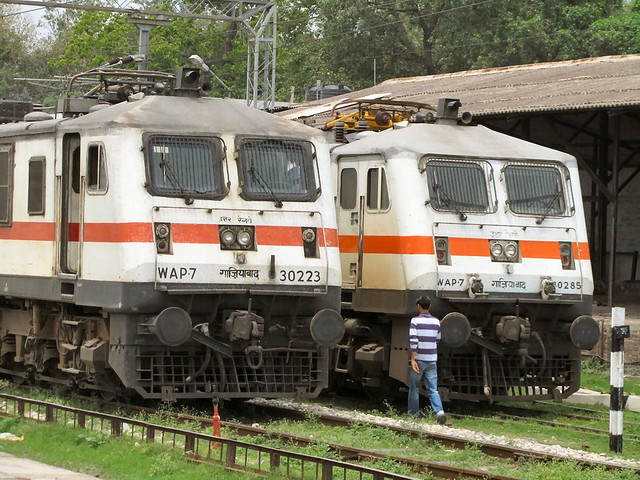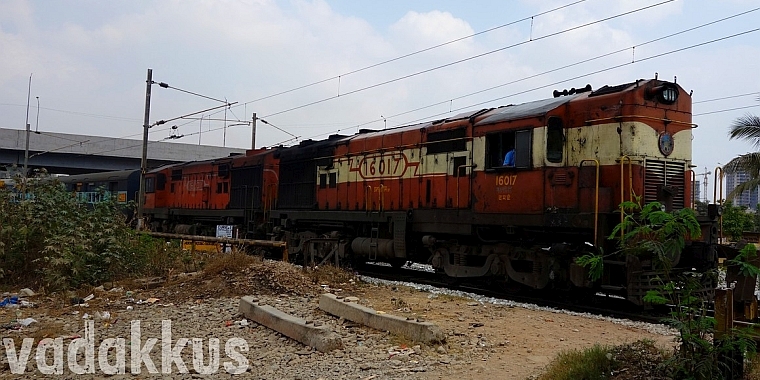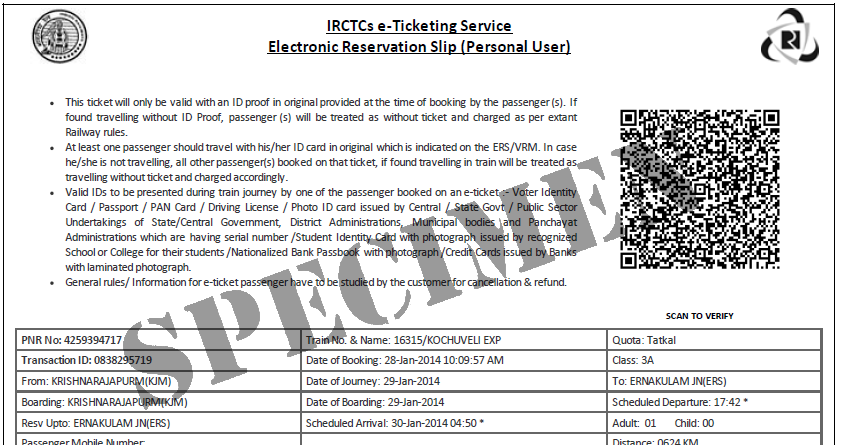Indian Railways History – The Greatest Projects

The general history of the Indian Railways after independence might seem mostly been bland, generally indifferent and unexciting thanks to the agonizingly slow progress IR has shown. But it was not so. The Indian Railways have undertook some really groundbreaking and mammoth projects since independence, projects of sheer size and scale which transformed the railways to what it is today and turned it around many times. Putting aside our usual indifference and “chalta hai” attitude, some great men and women pushed forward and labored for these epic undertakings without which IR wouldn’t even have existed today. Presenting the greatest of them:
Project Unigauge
Project Unigauge aims at changing all of IR network into Broad Gauge and is one of the most ambitious and far-reaching endeavors the Indian Railways has ever undertaken. The need for this was to bring in uniformity in the network and to avoid break journeys, complications in track and other infrastructure design, for efficient utilization and easier acquisition of rolling stock and to reduce overhead by having to maintain only one set of uniform systems throughout the country. Broad Gauge was chosen for obvious reasons: It was the most prevalent gauge and the widest, which meant larger coaches and wagons which again will mean more freight, space, speed, “airiness”, carrying capacity and stability in turbulent weather. From 47% of share in 1951, Broad Gauge has come up to have 85% of track route share of the total network in 2011. Only some 6000 km of Metre Gauge track remaining in India and most of which are unimportant spurs. No major mainline trunk routes remain as Metre Gauge today. All MG lines except heritage Railway lines like the Nilgiri Railways will be eventually converted to Broad Gauge.
Coaching and Rolling Stock
Before independence, most carriages were made of wood paneling with some having a body base made of metal. Any large enough woodworking facility could produce railway carriages on their own in any configuration or design they liked and according to order. After the formation of IR, the Integral Coach Factory (ICF) and the Rail Coach Factory (RCF) were set up to exclusively manufacture coaches for the railways, to be based on one standard configuration only for uniformity. The design and technology used for these new coaches were path-breaking at the time and featured integral and telescopic coaches made of steel. The body shells of all coaches were designed by Schlieren AG of Switzerland, who also helped in setting up the ICF at Permabur near Chennai. If you wonder how those coaches looked like, just look at majority the coaches in use today. Yes, no one ever thought of changing those designs and typical to everything in India, it remains mostly unchanged till date save some minor cosmetic changes. It took 50 years to get rid of this inertia and in 2000 we started procuring lightweight and modern LHB Alstrom coaches from Linke Hoffmann-Busch. These coaches brought in a breath of fresh air into the railways and were first introduced on premier trains like Rajdhanis, Shatabdis and Durontos but are now being extended to other trains as well. But what IR desperately needed at the time of independence was Locomotives.

Locomotives
Out of 8078 standalone locomotives present in India at the time of independence, a whopping 7988 were steam. Out of these, 2233 were more than 35 years old, including 357 which were more than 45 years old! Most of them like the old Vulcans imported from England during the 1920 and 30s were antique pieces which when actually worked could not pull more than 5 coaches at a time. Shunting locomotives were virtually absent that we actually had to use elephants to shunt wagons and coaches for many years! As a result, many trains could simply not run and many lines lay idle across the country. To meet the initial demand, a large number of (a thousand?) new steam locomotives were imported from British and American manufacturers between 1946 and 1956. To indigenously produce locomotives for IR, CLW was founded just two years after independence and the first loco rolled out in 1950. The plan was to continue to invest in steam as Diesel was expensive and unknown and Electric needed more technological know-how. By 1962 IR was very rich in locomotives with 11,000 locos out of which 10,500 were steam! But IR had woken up since the 1956 Ariyalur disaster and realized that we were still stuck in the stone-age and modernization by switching to diesel and electric traction was terribly overdue. Steam was phased out over the next couple of decades with production stopping in 1970 and the last regular steam operation ceasing in 1985. All steam locomotives were withdrawn from active service by 1990. The WDM-2 and YDM-4, IR’s most successful BG and MG diesel locos respectively, were introduced in 1962 and successful electrics like the WAG 1 -4 and WAM 1-4 were rolled out between 1964 and 1970. The ground breaking WAP-1, India’s first electric traction locomotive specialized for passenger services was introduced in 1980. The hugely successful WAM series in addition to the WCAM locos of Mumbai which can run on both AC and DC were used for passenger services until then. IR’s “Golden Age” of modern locomotives began in 1988 with the introduction of the WAG-5. Today IR has in total 9213 locomotives, 5137 of which are Diesel and 4033 are electric engines.
Electrification (CORE)
Electric traction is used as the first choice by railways around the World because it is efficient, clean, powerful and technologically superior. The British realized this long back but we were slow in adapting it. If you think electrification of railway lines is a fairly recent phenomenon, think again. The Mumbai area circuit (VT – Churchgate – Virar – Kalyan – Kurla – Igatpuri) and the Mumbai – Pune line were electrified by the British way back from from 1925 to 1936 with 1500V DC! And these were the only electric lines we had at the time of Independence, a total of 388 km! The Kolkata suburban area was electrified using 3kV DC around 1954. Anyway, by the end of the 1950s, it seemed pretty obvious that the “steam strategy” was not working and had to go. Mainline electrification was seriously suggested after the Ariyalur accident in lieu of adopting modern technology. SNCF, the French railways who were the expert in the field those days suggested IR use 25kV AC traction following the success of that format in France. It was approved and by the 1960s mainline electrification of lines of the erstwhile undivided Eastern Railway had begun in earnest and electrified route km jumped from 758 km in 1961 to 3,708 km in 1971! There was a furious debate in the 1960s and 70s whether Diesel or Electric was to be adopted as primary traction and it is said that the debate was akin to the “Android or iPhone” debate these days. After numerous studies and committees, Electric won largely thanks to the repeated fuel shortages of the 1970s and the overall cost factor. In 1979 it was decided that all trunk routes were to be aggressively electrified and the Central Organization for Railway Electrification (CORE) was set up to achieve this end. An ambitious target of 1000 km of route to be electrified every year was set which of course would not be achieved but would come close. In the 25 years from 1980 till 2005, a whopping 23,066 track kilometers or 12,562 route kilometers have been electrified, which is about 2.52 km of track electrified per day on an average for 25 years! Pretty impressive by Indian standards! CORE has helped us a lot in saving precious foreign exchange and speeding up our trains to some extent.
Computerized Passenger Reservation System
Once upon a time, booking tickets on trains was a daunting task. There were only a limited number of trains and a limited number of reserved seats. Reservation was handled by a complicated system of manually handwritten ledgers, registers and could be done only from originating or very big stations on the route of the train or by telegraph, if you knew the process. It was almost impossible to reserve a ticket from an intermediate station from which you would want to board the train, forget from some station at another end of the country. Computerization of reservation systems changed all that. It literally “opened up” the railways by making it more “accessible” to traveling public, there by drastically increasing traffic and revenues.
In 1986, CRIS, the Center for Railway Information Systems was established to handle everything related to IT in the Indian Railways. And the Passenger Reservation System (PRS) is only one among the several projects that CRIS handles. The PRS was started as a standalone reservation system at Delhi in 1985 (called IMPRESS) to handle computerized reservations for a few trains. It was then extended to Mumbai, Chennai , Kolkata (all in 1987) and Secunderabad (1989) and by 1990 most of the long distance train reservations were computerized as far as the railways were concerned. But this was not much of use for the general traveling public who still had to go their originating stations to book tickets as all these five PRS systems stood independent with their own databases. But work was underway to interconnect them to form one network. This finally became a reality on April 18 2000 when CONCERT, The Indian Railways’ (CRIS) software/database system enabling real-time ticket booking went online. Finally the general Indian public could book a train ticket from anywhere to anywhere from anywhere in the country, on any train and class they wanted. And this went a step further with the launch of the now infamous online booking website by IRCTC in 2005.
CONCERT still handles all passenger reservation systems across the country for 3000+ trains of 12 types in 7 classes across 500+ stations for 60 days among 40 quotas and 80 types of concessional fares across 7000 PRS counters, dozens of agent websites and the IRCTC website. In fact, IRCTC is just the front end of which also plugs into the CONCERT database, which actually never goes down! All in real time. Beat that. One of the most complicated and intricate database systems in the World. The programming languages CONCERT works on? C and, hold your breath, FORTRAN. Be thankful.
But, no discussion about the Indian Railways is complete without that one undertaking of epic proportions which would single handedly change the lives of millions of people along an entire coastline, a feat that was once considered impossible, easily the biggest infrastructure project ever undertaken in the history of India. More about that in the next part.
Previous Part (06) – Indian Railways Post Independence History







FORTAN is one brilliant language especially for speed. It can even beat C. Numerical operations are always done in the processor. No wonder it still finds place in Space research